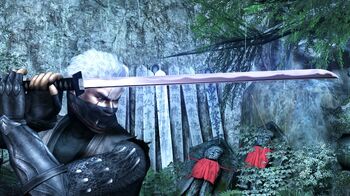The ninjatō (忍者刀), also known as Ninjaken (忍者剣) or shinobi gatana (忍刀), is the most common name for the reputed sword a ninja would have carried. According to the book "Ninjutsu History and Tradition" by Masaaki Hatsumi, Soke (Headmaster) of the Bujinkan Dojo system, these swords came in a variety of shapes and sizes. Often, however, they were much shorter than the traditional daito katana used by the samurai of feudal Japan.
The typical ninjatō carried by a ninja would most likely have been a wakizashi or cut-down katana, perhaps even an aikuchi or most likely a chokuto fitted with a katana-length handle and placed in a katana-length saya (scabbard). This may have been used to deceive one's opponents into miscalculating how quickly it could be drawn, allowing one to use a battoujutsu strike faster than expected. It also disguises the weapon (that would easily identify them as a ninja) as a common sword. The extra space in the saya may also be used to store or hide other equipment or goods. Of course, a shorter blade forces the fighter to get closer to his opponent, which may be a disadvantage or an advantage when facing an opponent armed with full length swords, or in an iai duel when, to enhance chances of striking first, you'd draw as soon as your blade's length allowed, and make full use of its slashing ability, while a shorter blade tends to be used in more of a stabbing style. However, most authorities believe the shorter blade to be an advantage in terms of concealment- the Ninja would have avoided conflict to begin with, and spend a lot of time hiding in small places- and more importantly better suited to indoor combat; If the spy was revealed, the assassin discovered, and it came to a fight, then a shorter, straighter blade would serve the Ninja better in close quarters. Corridors, for example, would seriously hamper a Samurai using a Katana, or several using wakizashi, to say nothing of ceiling clearance on a down stroke/slash.
Modern ninjato are often straight with a square tsuba (hand guard), but this is not historically accurate. According to the same book by Masaaki Hatsumi, the ninja ken was straight, but only in contrast to the average sword of the period which were much more curved. The ninja ken still had a slight curve to the sword. Hatsumi says that they were often straight bars of low-quality steel with an edge ground on to them. According to other sources, some of the swords being forged during the Tokugawa era also had blades with less curvature than others. This was also the period during which the mythology of the ninja grew as they were employed by the Shogun as secret police.
The Bujinkan dojo currently contains one school, the Togakure ryu, which teaches the use of the ninja ken. Typically, this is a wakizashi-length sword (or slightly longer) that has been outfitted with katana sized koshirae (fittings). The idea behind a shorter sword is that it is much easier to fight in close quarters with a shorter sword, as would be necessary for a ninja acting as an intelligence-gatherer.
References
- A Glossary of Arms and Armor, ed. George C. Stone, Southworth Press, 1961, p. 469
- Ninjutsu: History and Tradition, by Masaaki Hatsumi, Unique Publications, 1981, ISBN 978-0865680272
- Secret Guide to Making Ninja Weapons, by Yamashiro Toshitora, Butokukai Press, 1986, ISBN 978-9994291311
- The Mystic Arts of the Ninja by Stephen K. Hayes, Contemporary Books, 1985, ISBN 0809253437
- "Ninja Swords - Did They Exist Historically?" Sword Forums International, Summer 1999.
- Link to BBC article from the Japan - No Surrender series
- Link at sword-buyers-guide.com to general article
- Link at Kris Cutlery.com
| This page uses Creative Commons Licensed content from Wikipedia (view authors). | 
|
